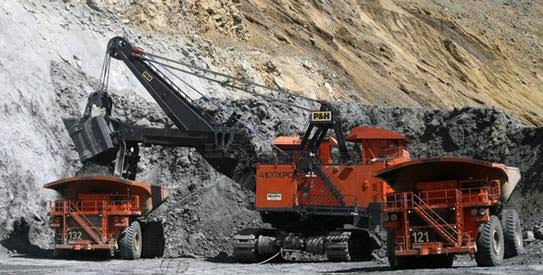Pakistan, a country blessed with abundant mineral resources, has a unique opportunity to unlock its potential and become self-sufficient in the mining industry. By focusing on the exploration and development of its mineral reserves, Pakistan can not only enhance its economic growth but also establish a foundation for long-term prosperity. With the right strategies, investments, and the role of technology, the country can harness the benefits of mineral mining, reduce dependency on imports, and pave the way for self-sufficiency. However, it is important to note that implementing and executing these strategies is more challenging than it may seem.
Pakistan has a broad-based mineral sector with extensive deposits of coal, copper, iron ore, gold, zinc, lead, rock salt, and construction minerals like limestone and gypsum. Currently, over 50 minerals and elements are being exploited in the country through surface or underground mining sites. The extensive list of minerals also includes rock phosphate, marble, granite, bauxite, bentonite, dolomite, calcite, silica sand, and various precious and semi-precious stones.
Expanding the exploration efforts in these areas can lead to the discovery of new deposits and the development of viable mining operations. By leveraging advanced technologies and expertise, Pakistan can unearth its mineral riches and utilize them for economic growth. A prime example to follow is the Thar Coal project. Pakistan possesses the world’s 7th largest coal resources, with 186 billion tons of coal, out of which 175 billion tons are found in Thar. This is 50 billion tons more than the oil reserves of Saudi Arabia and Iran combined. In Thar Block II, the Sindh Engro Coal Mining Company (SECMC) initiated the mining construction project in 2016 and achieved its first COD (Commercial Operation Date) in July 2019. Currently, SECMC produces 7.6 million tons per annum (Mtpa) of coal and supplies Thar Coal to power plants, generating approximately 1,320 MW of inexpensive electricity for the national grid.
However, to fully harness this potential of the rest of the minerals, further advancements in technology and a supportive framework are essential for Pakistan’s mining industry. In September 2022, President Dr. Arif Alvi emphasized the need for using satellite imagery technology, modern mineral detection, analysis, and exploration technologies, as well as training relevant human resources in modern and safe mining methods.
Although the state of technology in mining in Pakistan has witnessed notable progress, there is still considerable room for improvement. While traditional mining methods have been the norm, integrating modern technologies can significantly enhance efficiency and productivity in mining operations.
One area that holds immense promise is the utilization of drones for geological mapping and surveying. Drones equipped with advanced imaging and mapping technologies can quickly and accurately assess large areas, identifying potential mineral deposits with precision. This can expedite the exploration phase and reduce costs, allowing mining companies to make informed decisions regarding resource extraction.
Furthermore, remote sensing techniques, such as satellite imagery and airborne geophysical surveys, offer valuable insights into the geological composition of a region. By analyzing data obtained through these methods, geologists can identify areas with high mineral potential, guiding mining efforts towards the most lucrative targets.
In terms of mining operations, the implementation of automated machinery can revolutionize the industry, although achieving this may require long-term planning. Automated machinery not only improves efficiency and productivity but also enhances safety by reducing workers’ exposure to hazardous environments. These technologies can handle repetitive and physically demanding tasks, allowing human operators to focus on supervisory roles and complex decision-making processes.
Moreover, the adoption of advanced data analytics and artificial intelligence (AI) can optimize the extraction process. By analyzing real-time data from sensors, AI algorithms can enhance ore sorting, streamline processing, and improve energy efficiency. This can lead to significant cost savings and, making mining operations more sustainable in the long run. Additionally, partnerships with international mining companies and technology providers can facilitate knowledge transfer and the exchange of best practices.
The sector having significantly contributed to the country’s foreign exchange earnings, generating $1.5 billion in back in 2018-19. However, the contribution of this sector to Pakistan’s GDP growth is only 2.51% in 2019. According to the Economic Survey of Pakistan, the Mining and Quarrying sector of Pakistan had a negative growth rate by 8.82% during July – February 2020 as against 3.19% decline in 2019.
Despite possessing significant reserves of valuable minerals in high demand, Pakistan’s mineral mining industry lags significantly behind other developed and developing nations such as Russia, Australia, Canada, China, and Iran.
Pakistan stands at a critical juncture in its mining industry, with vast untapped mineral resources waiting to be explored and harnessed. By prioritizing the exploration and development of these resources, Pakistan can achieve self-sufficiency, drive economic growth, and reduce dependency on imports. However, the role of advanced technology plays a major role in achieving these goals. A strong mining industry would create employment opportunities, enhance industrial growth, and contribute to overall economic stability. Through strategic investments, collaboration, a supportive regulatory framework, and advanced technologies, Pakistan can unleash the true potential of its mineral mining industry, propelling the country towards self-sufficiency in the long run.








